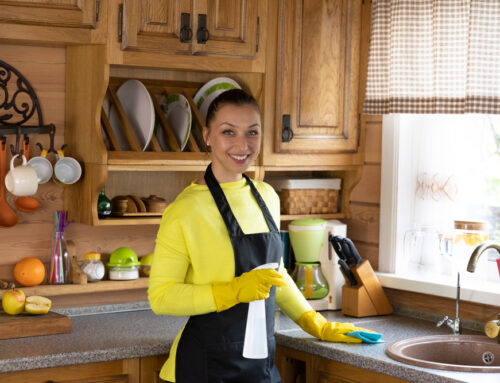As winter blankets the world in snow and cold, we find solace in the warmth of our homes. Yet, with the cozy atmosphere comes a silent threat: germs. The winter months often see a surge in illnesses, making it essential to understand the science of disinfection. In this comprehensive guide, we’ll uncover the intricacies of “The Science of Disinfection: Keeping Your Home Germ-Free in Winter.”
The Science of Disinfection
Revealing the Microscopic World
To truly appreciate the science of disinfection, we must delve into the microscopic realm that surrounds us. Our homes are not just shelters; they are bustling ecosystems inhabited by a multitude of microorganisms, including bacteria, viruses, and fungi. While most of these tiny creatures are harmless, some can wreak havoc on our health, especially during winter when we spend more time indoors.
Temperature’s Influence
Winter’s chill affects not only our comfort but also the survival and transmission of germs. Interestingly, some viruses thrive in colder temperatures, making it crucial to maintain proper indoor hygiene to combat their spread.
The Humidity Factor
Humidity levels within your home play a significant role in germ dynamics. Low humidity can lead to dry mucous membranes, rendering us more susceptible to infections. We’ll explore the ideal humidity range to keep your home germ-free.
Identifying Germ Hotspots
Before we embark on our germ-fighting journey, it’s vital to identify the areas where germs tend to congregate in your home. From frequently touched doorknobs to the often-neglected kitchen sponges, we’ll shine a light on these hidden danger zones.
The Science of Cleaning
The Basics Unveiled
Effective cleaning is the cornerstone of a germ-free home. In this section, we’ll unravel the mysteries of various cleaning agents and tools, ensuring you have the knowledge needed to maintain a pristine environment.
Soap and Water’s Magic
Believe it or not, soap and water are your most potent weapons against germs. We’ll explore why proper handwashing is paramount and how it can thwart the spread of infections effectively.
Decoding Disinfectants
Not all surfaces demand heavy disinfection, but some certainly do. We’ll guide you through the different types of disinfectants available and when it’s necessary to use them to achieve maximum germ-fighting power.
The Air We Breathe
While we often focus on surfaces, indoor air quality is equally crucial in the battle against germs. Discover how to enhance the air you breathe within your home during the winter months.
Germ-Fighting Strategies
Now that we’ve delved into the science of disinfection and explored the various aspects of keeping your home germ-free in winter, it’s time to roll up our sleeves and put this knowledge into action. In this section, we’ll provide you with practical germ-fighting strategies that will ensure a healthy living environment for you and your family during the cold season.
Personal Hygiene Practices
Your personal habits have a profound impact on the cleanliness of your home, especially during winter. Here are some essential personal hygiene practices that can make a significant difference:
- Regular Handwashing: The importance of this cannot be stressed enough. Wash your hands frequently with soap and warm water for at least 20 seconds. Proper handwashing is one of the most effective ways to prevent the spread of germs.
- Proper Respiratory Etiquette: When you cough or sneeze, do so into a tissue or the inside of your elbow, not your hands. This helps prevent the transmission of respiratory germs.
- Use Hand Sanitizer: When soap and water are not readily available, carry a hand sanitizer with at least 60% alcohol and use it to disinfect your hands.
- Avoid Touching Your Face: Germs often enter our bodies through our eyes, nose, and mouth. Try to avoid touching your face, especially with unwashed hands.
- Dispose of Tissues Properly: If you use tissues, dispose of them in a lined trash can immediately after use.
Creating a Cleaning Routine
Consistency is the cornerstone of a germ-free home. To ensure that your living space remains a bastion of cleanliness throughout the winter, consider implementing a structured cleaning routine. Here’s a sample schedule to get you started:
- Daily Cleaning: Focus on high-touch surfaces such as doorknobs, light switches, and remote controls. Disinfect these surfaces at least once a day.
- Weekly Cleaning: Set aside a specific day each week for more comprehensive cleaning. This can include vacuuming and mopping floors, wiping down kitchen countertops, and sanitizing bathroom surfaces.
- Monthly Cleaning: Dedicate time once a month to deep cleaning tasks. This might involve cleaning out your refrigerator, dusting hard-to-reach areas, and washing curtains or blinds.
- Seasonal Cleaning: At the start of each season, consider a thorough cleaning of your home. This includes cleaning windows, changing HVAC filters, and inspecting your home for any areas that may need repairs or maintenance.
Choosing the Right Cleaning Products
Not all cleaning products are created equal, and the market can be overwhelming. Here are some tips to help you navigate and choose the most effective and safe cleaning products for your home:
- Read Labels: Always read the labels on cleaning products. Look for those that specifically mention they are effective against viruses and bacteria.
- Eco-Friendly Options: Consider using eco-friendly cleaning products. They are not only effective but also environmentally responsible.
- Avoid Mixing Chemicals: Never mix cleaning products, as this can produce harmful fumes. Stick to one product at a time.
- Test in Small Areas: If you’re trying a new product, test it in a small, inconspicuous area first to ensure it doesn’t damage surfaces.
Designing for a Germ-Free Home
Believe it or not, your home’s interior design can play a significant role in the battle against germs. Here are some design considerations to help you create a home that’s not only aesthetically pleasing but also easy to clean and maintain:
- Choose Easy-to-Clean Materials: Opt for materials that are easy to wipe down and disinfect, such as smooth, non-porous surfaces for countertops and flooring.
- Minimalism: Embrace a minimalist approach to reduce clutter, as cluttered spaces are harder to clean.
- Use Washable Fabrics: When selecting furniture and textiles, choose washable options. This makes it easier to clean and refresh your living space.
- Consider Air Quality: Invest in houseplants that can improve indoor air quality, and ensure proper ventilation in your home.
By incorporating these germ-fighting strategies into your daily routine and home design, you’ll be better equipped to maintain a clean and healthy living environment throughout the winter months.
In conclusion, Disinfection is not just a topic—it’s a crucial aspect to ensuring a healthy and enjoyable winter season. Armed with the knowledge of germ science, proficient cleaning practices, and effective strategies, you can create an environment that promotes well-being for you and your loved ones. So, as winter descends, stay warm, stay safe, and embrace the season with confidence, knowing that your home is a haven free from the worry of germs.





